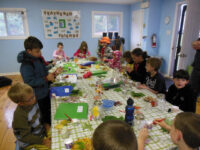Press Release
Mississippi Valley Field Naturalists
January 29, 2007
by Howard Robinson
Linda Touzin Meets the Challenge for Best Forestry Practices While Protecting the Watershed
See Linda’s Recommended Links for information on how to keep your woodlot healthy
 The Mississippi Valley Field Naturalists (MVFN) continued its lecture series of talks related to the “Mississippi Valley Watershed”. On 18rd January the lecture was well attended, by woodlot owners and others, with Linda Touzin presenting valuable and interesting information on “Managing forests to protect the watershed”.
The Mississippi Valley Field Naturalists (MVFN) continued its lecture series of talks related to the “Mississippi Valley Watershed”. On 18rd January the lecture was well attended, by woodlot owners and others, with Linda Touzin presenting valuable and interesting information on “Managing forests to protect the watershed”.
The Mississippi Valley, Ms. Touzin said, has a very high percentage of wooded area compared to other developed parts of Ontario. It must be well managed in order to acquire wood products in a sustainable fashion without severely impacting the environment including our watershed.
There is much evidence of a cleaning effect for streams that pass through forests. It is hard to put a value on streams, wetlands and other kinds of ‘natural capital’. On the other hand it is easy to understand the economic value of woodlands and wood as a natural and renewable resource continues to increase in value.
The Mississippi Valley is in the Mazinaw-Lanark crown forest management unit and is the most southerly such unit in Canada . One third is Crown land and the rest is private. A sustainable harvest is guided by an extensive forestry plan covering a 20 year period with a view looking beyond 100 years. A detailed plan, which may take 2.5 years to produce, includes a lengthy consultation process and public input. Healthy collaboration with all concerned is a key part of the plan, with concerns generally met through guidelines based on science and core values.
While the plan is for a sustainable harvest, the operational plan and ‘silviculture system’ used have many considerations for protection of the environment and its watershed. Road building and logging must avoid damage to the watershed from run off, soil erosion with its excess nutrients and operational degradation. Heavy machinery around the watershed is avoided and a 30 metre minimum buffer is left near watersheds. Depending on the incline to the water and soil type, this buffer is increased.
Most harvesting is done on a partial cutting system where there is a general ‘thinning’ of trees of various ages suitable for wood products. The forest is left to regenerate with an ‘acceptable growing stock’ i.e. mix of age and trees known to help improve the forest and value of the resource. Danger trees may be taken down but care is also taken to identify all ‘forest values’ such as nesting sites, cold-water streams, vernal pools, or rare species which will be left with a ‘no-cut’ buffer. Harvesting is not done during the nesting season. Clear cutting done over ~ 17% of the area currently, involves primarily short life tree types that may be predominant in an area (e.g. Birch) and which will regenerate.
Linda demonstrated her excellent knowledge and experience as a Registered Professional Forester and answered many good questions from both MVFN members and others interested in private woodlot management. Linda stressed that sustainable forest management can be practiced by private landowners using the same best practices used by OMNR on crown lands. The information and tools are readily available and with public involvement in public processes we can all make a difference.
The signs of a healthy forest were described as having a diversity of species appropriate for the eco-site, vigorously growing native trees, forest values protected from timber harvest operations, having a variety of types and ages of trees and habitat features while also having demonstrated careful logging practices.
Finally, Linda advised those with wood lots to KEEP THEM, walk through all corners of your property making an inventory, keep good species, remove exotics, and whenever and wherever possible increase your woodlot or connect it with others. Make a plan for your woodlot and then choose consultants and tree markers accordingly, based on your plan and what you value most in your woodlot.
If you want to know how to keep a woodlot healthy or where landowners can turn for help, Linda’s recommended links are posted on MVFN’s website at www.mvfn.ca.
MVFN’s lecture series continues Thursday February 15th with Paul Hamilton of the Canadian Museum of Nature who will discuss “Water Quality”, 7:30 p.m. at the Almonte United Church, 106 Elgin Street in Almonte.
For more information please contact Joyce Clinton at 613-257-4879 or clintonj@magma.ca, or visit www.mvfn.ca.






